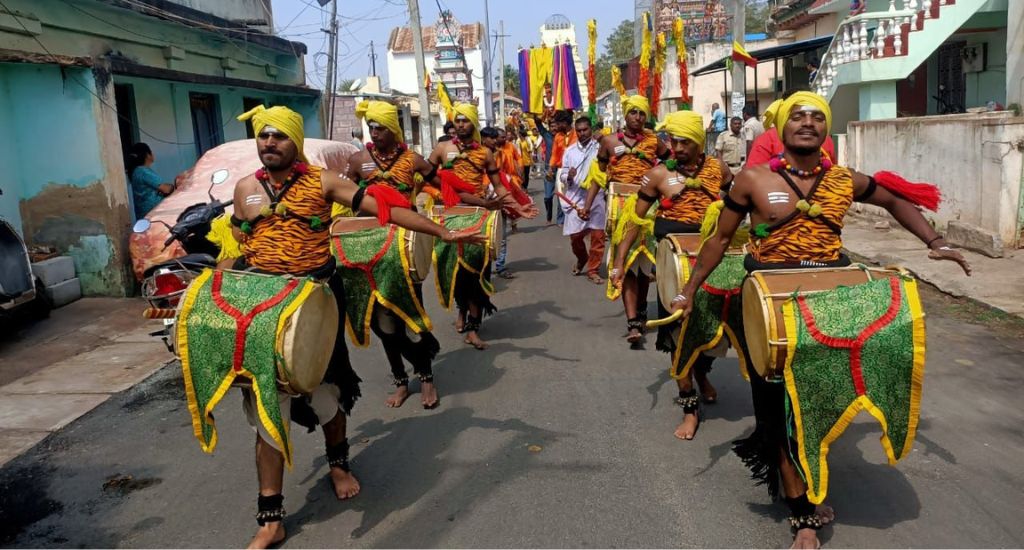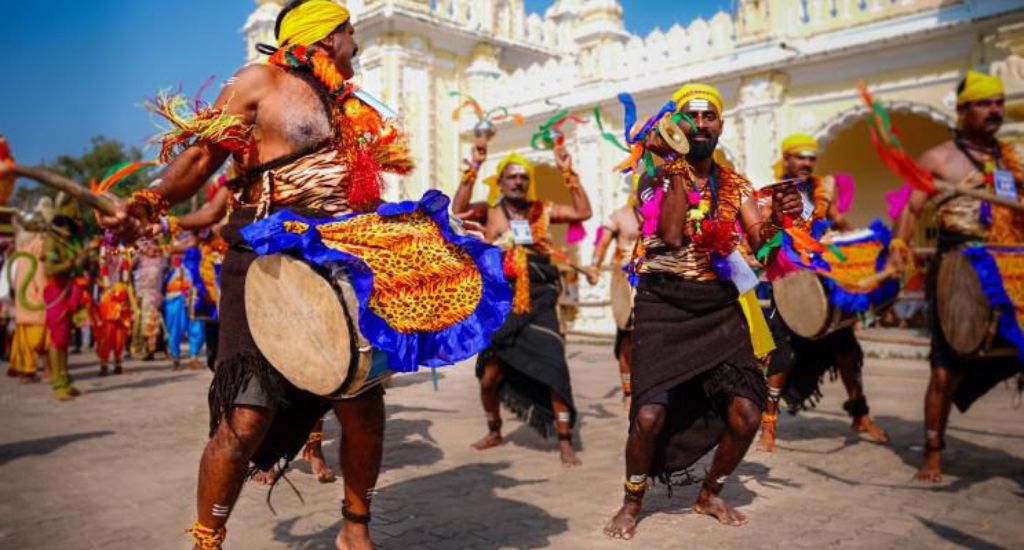
Dance to the beats of dollu at this Karnataka festival
In Karnataka’s folk heritage, the energetic drum dance of dollu kunitha weaves together devotion, tradition, artistic expression, and entertainment, connecting people with their roots.

In Karnataka’s folk heritage, the energetic drum dance of dollu kunitha weaves together devotion, tradition, artistic expression, and entertainment, connecting people with their roots.
Deep into the night, the sound of drums reverberated through a village in the hilly and wooded expanse of Shimogga district in central Karnataka. Barefoot dancers pulsated to the beat in colourful clothing – dhoti, angavastra (a shoulder cloth or stole worn by men), and turban. Dozens of people squeezed in for a closer look, their cell phones lighting up the spectacle.
Embedded in Karnataka’s cultural traditions, dollu kunitha of the Halu Kuruba tribe has been dancing its way into the hearts of celebrants during vibrant festivals like Maha Shivaratri and Ganesh chaturthi. This dynamic traditional folk dance finds its soul in the beat of a large barrel-shaped drum, symbolising a blend of entertainment, culture, and spirituality.
The art form’s name itself reveals its core components: “dollu”, referring to the distinctive drum, and “kunitha”, signifying dance in the Kannada language. The dance’s heartbeat is the rhythmic drumming, vibrant movements, and coordinated group formations.
The dance demands strength, muscle power, and endurance, making it a performance reserved for well-built men. Dollu Kunitha troupes, consisting of about a dozen men, use instruments like tala, tappadi, trumpets, gong, and flute, enhancing the rich vibrations of the dollu.

During performances, a semicircle of dancers engages in swift and joyously energetic movements. A leader in the centre directs the beats with cymbals. The rhythm alternates between slow and fast, creating a dynamic and captivating performance.
Beyond entertainment, this dance holds cultural and religious significance, often featured in religious processions, fairs, and traditional events. “It’s not just a dance, it’s a way of life. It’s a culture and a religion,” said Siddanna, an ardent admirer of the art form.
Dollu kunitha is intertwined with the worship of Beereshwara, another name for god Shiva, in the temples across the region. In Beereshwara temples, the dollu hangs from the ceiling. The sacred drum becomes an instrument of spiritual connection during worship ceremonies, symbolising the divine link between the earthly and the celestial.
The dance’s origin, narrated through the oral tradition of Halumatha Purana or Kuruba Purana, weaves a mythical tale. The demon Dolla-asura, a devout worshiper of Shiva, sought immortality but faced the god’s refusal. In a divine confrontation, Dolla-asura attempted to consume Shiva, leading to his demise. Shiva, in turn, used the demon’s skin to craft the dollu, presenting it to his devotees, the Halu Kurubas.

This tradition continues among the Halu Kuruba tribes in Shimogga, emphasising the enduring cultural significance of dollu Kunitha. The drum, made from the demon’s skin, symbolises a connection between the spiritual and the celebratory aspects of the dance.
Dollu songs, or drum songs, accompany dollu kunitha. These songs create a multisensory experience, enhancing auditory and visual elements for the audience.
The Kuruba Gowdas sing with a distinct intonation that sets them apart from other folk singers. The songs trace the genealogy, evolution, and development of the Kurubas, adding depth to the dance’s cultural narrative.
Dollu kunitha isn’t just a dance. It is a sacred expression of devotion, a cultural narrative, and a dynamic art form that transcends time. It’s the focal point around which community celebrations thrive, becoming an inseparable part of cultural festivities.
For Siddanna, the dance adds vibrant energy to festivals. “Every Maha Shivaratri, I eagerly wait to watch dollu kunitha. The infectious drumbeats encourage impromptu dancing, turning the festival into an unforgettable celebration.”

Though the dance is traditionally performed at religious events, it has been doing more and more public performances in recent years, including collaborating with mainstream musicians. Performers have done shows at several festivals and cultural powwows across India, gaining recognition beyond Karnataka.
For Hidayath Ahamad, a performer deeply rooted in dollu kunitha, teaching this traditional folk dance to aspiring learners is a source of immense pride and fulfilment. “I have completed my post-graduation in theatre and arts, and also a diploma in folk. I have been performing dollu kunitha for the past 15 years. I take immense pride in performing across Karnataka. Being part of the folk team gives me great joy,” he said.
His journey reflects the deep connection performers feel to their cultural heritage. Dollu kunitha stands as a living testament to the resilience of folk traditions, evolving through time yet retaining its authenticity and vibrancy.
The lead image at the top shows doll kunita performers parading through the village with the deity (Photo by Hidayath)
Apta Ramesh is a former television show producer, and presently a freelance journalist.